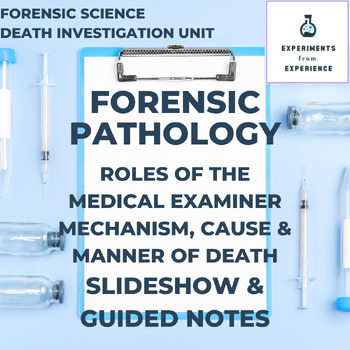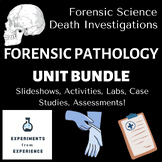Forensic Pathology Google Slideshow & Guided Student Notes
Experiments from Experience
18 Followers
Grade Levels
Not Grade Specific
Subjects
Resource Type
Standards
CCSSRST.11-12.1
CCSSRST.11-12.2
CCSSRST.11-12.3
CCSSRST.11-12.4
CCSSRST.11-12.5
Formats Included
- Google Docs™
Experiments from Experience
18 Followers

Includes Google Apps™
This bundle contains one or more resources with Google apps (e.g. docs, slides, etc.).
What educators are saying
Perfect set of notes for my forensics class. Also loved the additional virtual autopsy lab activity. Can't wait to use them!
Products in this Bundle (2)
Bonus
Virtual Autopsy Lab
Also included in
- Estimating the Post Mortem Interval, estimating time of death, and learning the roles of the Medical Examiner, this unit will help your students engage in the field of Forensic Science. If you are struggling to create a creative, engaging unit about Death Investigations and Forensic Pathology, lookPrice $34.99Original Price $37.23Save $2.24
Description
A great introduction to Forensic Pathology and the role of the Medical Examiner! I always begin my Death Investigation Unit with this slideshow. This bundle includes an editable Google Slides presentation (57 slides of content) and guided student notes.
Students will learn the following:
- The roles & responsibilities of the medical examiner
- How the autopsy performed helps the medical examiner determine the mechanism, cause and manner of death
Resource includes:
- Forensic Pathology Google Slides
- Printable Student Fill-in-the-Blank Notes
Total Pages
Answer Key
N/A
Teaching Duration
N/A
Report this resource to TPT
Reported resources will be reviewed by our team. Report this resource to let us know if this resource violates TPT’s content guidelines.
Standards
to see state-specific standards (only available in the US).
CCSSRST.11-12.1
Cite specific textual evidence to support analysis of science and technical texts, attending to important distinctions the author makes and to any gaps or inconsistencies in the account.
CCSSRST.11-12.2
Determine the central ideas or conclusions of a text; summarize complex concepts, processes, or information presented in a text by paraphrasing them in simpler but still accurate terms.
CCSSRST.11-12.3
Follow precisely a complex multistep procedure when carrying out experiments, taking measurements, or performing technical tasks; analyze the specific results based on explanations in the text.
CCSSRST.11-12.4
Determine the meaning of symbols, key terms, and other domain-specific words and phrases as they are used in a specific scientific or technical context relevant to grades 11–12 texts and topics.
CCSSRST.11-12.5
Analyze how the text structures information or ideas into categories or hierarchies, demonstrating understanding of the information or ideas.



